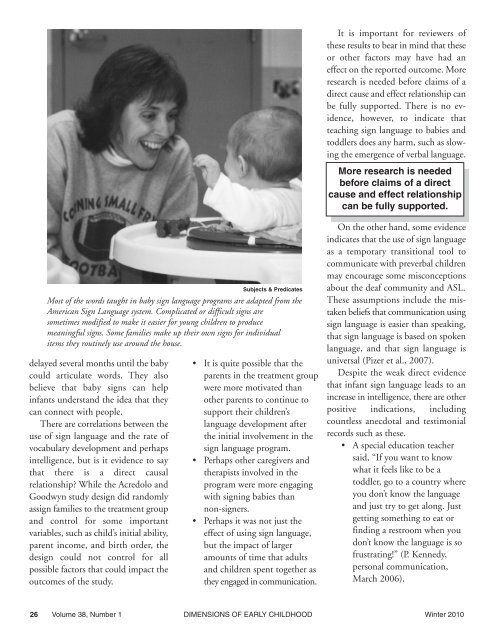90223 Dimensions Winter 10:Layout 1 - Southern Early Childhood ...
90223 Dimensions Winter 10:Layout 1 - Southern Early Childhood ...
90223 Dimensions Winter 10:Layout 1 - Southern Early Childhood ...
You also want an ePaper? Increase the reach of your titles
YUMPU automatically turns print PDFs into web optimized ePapers that Google loves.
It is important for reviewers of<br />
these results to bear in mind that these<br />
or other factors may have had an<br />
effect on the reported outcome. More<br />
research is needed before claims of a<br />
direct cause and effect relationship can<br />
be fully supported. There is no evidence,<br />
however, to indicate that<br />
teaching sign language to babies and<br />
toddlers does any harm, such as slowing<br />
the emergence of verbal language.<br />
More research is needed<br />
before claims of a direct<br />
cause and effect relationship<br />
can be fully supported.<br />
Subjects & Predicates<br />
Most of the words taught in baby sign language programs are adapted from the<br />
American Sign Language system. Complicated or difficult signs are<br />
sometimes modified to make it easier for young children to produce<br />
meaningful signs. Some families make up their own signs for individual<br />
items they routinely use around the house.<br />
delayed several months until the baby<br />
could articulate words. They also<br />
believe that baby signs can help<br />
infants understand the idea that they<br />
can connect with people.<br />
There are correlations between the<br />
use of sign language and the rate of<br />
vocabulary development and perhaps<br />
intelligence, but is it evidence to say<br />
that there is a direct causal<br />
relationship? While the Acredolo and<br />
Goodwyn study design did randomly<br />
assign families to the treatment group<br />
and control for some important<br />
variables, such as child’s initial ability,<br />
parent income, and birth order, the<br />
design could not control for all<br />
possible factors that could impact the<br />
outcomes of the study.<br />
• It is quite possible that the<br />
parents in the treatment group<br />
were more motivated than<br />
other parents to continue to<br />
support their children’s<br />
language development after<br />
the initial involvement in the<br />
sign language program.<br />
• Perhaps other caregivers and<br />
therapists involved in the<br />
program were more engaging<br />
with signing babies than<br />
non-signers.<br />
• Perhaps it was not just the<br />
effect of using sign language,<br />
but the impact of larger<br />
amounts of time that adults<br />
and children spent together as<br />
they engaged in communication.<br />
On the other hand, some evidence<br />
indicates that the use of sign language<br />
as a temporary transitional tool to<br />
communicate with preverbal children<br />
may encourage some misconceptions<br />
about the deaf community and ASL.<br />
These assumptions include the mistaken<br />
beliefs that communication using<br />
sign language is easier than speaking,<br />
that sign language is based on spoken<br />
language, and that sign language is<br />
universal (Pizer et al., 2007).<br />
Despite the weak direct evidence<br />
that infant sign language leads to an<br />
increase in intelligence, there are other<br />
positive indications, including<br />
countless anecdotal and testimonial<br />
records such as these.<br />
• A special education teacher<br />
said, “If you want to know<br />
what it feels like to be a<br />
toddler, go to a country where<br />
you don’t know the language<br />
and just try to get along. Just<br />
getting something to eat or<br />
finding a restroom when you<br />
don’t know the language is so<br />
frustrating!” (P. Kennedy,<br />
personal communication,<br />
March 2006).<br />
26 Volume 38, Number 1 DIMENSIONS OF EARLY CHILDHOOD <strong>Winter</strong> 20<strong>10</strong>
















